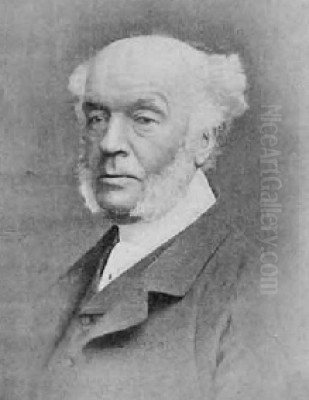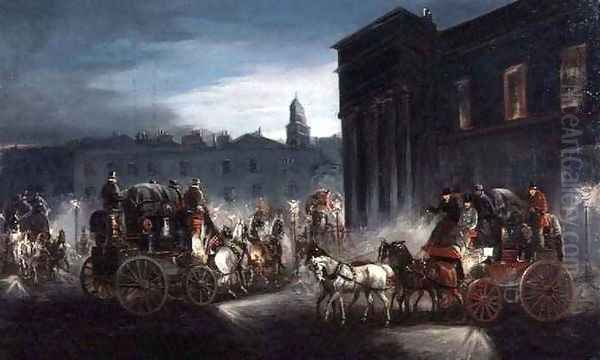
Charles Cooper Henderson (1803-1877) stands as a significant figure in British art, renowned primarily for his vibrant and meticulously detailed depictions of the coaching era. A quintessential British artist, his work captures the energy, romance, and daily realities of horse-drawn transport in the decades before railways dominated the landscape. His paintings serve not only as aesthetically pleasing works but also as invaluable historical documents of a bygone age.
Early Life and Artistic Inclination
Born near Charing Cross, London, in 1803, Charles Cooper Henderson came from a background connected to the arts and society. His father, John Henderson Sr., was an amateur artist and notable collector, particularly of watercolours. His mother, Georgiana Jane, was the daughter of George Keate, FRS, FSA, a writer and artist. This familial environment likely fostered Henderson's early interest in art. He received a solid education, attending Winchester College.
Initially, Henderson pursued a legal career, following a path common for young men of his standing. However, his passion for art, particularly for horses and the dynamic scenes associated with them, ultimately led him to abandon law and dedicate himself to painting. His independent means allowed him the freedom to pursue this vocation without the immediate pressure of commercial necessity, enabling him to develop his distinct style and subject matter. Early travels on the continent also broadened his artistic horizons, although his focus remained firmly rooted in British scenes.
The Specialist of the Coaching Age
Henderson's artistic identity is inextricably linked to the coaching age. He specialised in painting mail coaches, stagecoaches, post-chaises, and the powerful horses that drew them. His canvases bustle with activity: coaches thundering along country roads in varying weather, changing horses at bustling inn yards, or navigating the streets of towns and cities. He captured the essence of this mode of transport – its speed, its importance in communication and travel, and the skill required of the coachmen and guards.

His focus on this subject matter resonated with a public that was witnessing the rapid decline of coaching due to the rise of the railways. Henderson's work often evokes a sense of nostalgia for this passing era, celebrating its picturesque qualities and inherent drama. He understood the mechanics of the coach, the anatomy of the horse in motion, and the specific liveries and details that distinguished different coaching lines, lending his work an air of authenticity that was highly valued.
Artistic Style and Technique
Henderson worked primarily in oils, though he was also proficient in watercolour and etching. His style is characterised by a strong sense of realism combined with dynamic composition. He possessed a remarkable ability to render detail accurately without sacrificing the overall energy of the scene. The intricate harnessing of the horses, the construction of the coaches, the textures of road surfaces, and the specific architecture of inns were all depicted with careful observation.
His handling of horses was particularly adept. He captured their power, movement, and individual characteristics, understanding the different breeds used for coaching work. Unlike the more stylised depictions of some earlier sporting artists, Henderson aimed for anatomical accuracy and naturalistic poses, even amidst the high drama of a coach at full gallop. His use of colour was typically rich and descriptive, effectively conveying atmosphere, weather conditions – from bright sunny days to rain-lashed roads or lamplit nights – and the time of day.
His painting, The Edinburgh Mail Coach and other Coaches in a Lamplit Street (circa 1835), exemplifies his skill in capturing atmospheric effects, particularly the interplay of artificial light and shadow on wet streets, creating a scene full of nocturnal drama and movement. This attention to detail and atmosphere places him firmly within the tradition of British narrative and genre painting.
Key Works and Subjects
Among Henderson's most celebrated works is London To York Coaches Passing. This oil painting vividly portrays the energy and potential hazards of coaching travel, showing coaches navigating a potentially muddy or uneven road, highlighting the speed and power required. It encapsulates the dynamism that made his coaching scenes so popular and remains one of his most iconic images.
Other notable works further demonstrate his range within his chosen specialism. Paintings like A Replacement Horse or Bay Horse Being Led Out of a Barn show his skill in depicting individual horses with sensitivity and accuracy, focusing on the quieter moments surrounding the coaching industry, such as stable scenes or horse care. These works reveal his deep understanding and appreciation of the equine form.

Henderson often depicted specific, identifiable coaching routes or mail services, such as the London to Edinburgh mail or the Dover mail. These works appealed to patrons familiar with these routes and served as visual records of important national communication lines. The inclusion of recognisable landmarks or inn signs further grounded his paintings in the specific reality of 19th-century Britain.
Context and Contemporaries in British Art
Charles Cooper Henderson worked during a vibrant period in British art. While landscape painting reached new heights with masters like J.M.W. Turner and John Constable, and animal painting was popularized by figures such as Sir Edwin Landseer, Henderson carved out his niche in sporting and coaching art. He followed in the tradition of earlier horse painters like George Stubbs and Sawrey Gilpin, but focused more specifically on the coaching scene than many of his predecessors.
His contemporaries in the field of sporting and animal art included John Frederick Herring Sr., Ben Marshall, and James Pollard, the latter also being well-known for his coaching scenes. Henderson's work is often compared to Pollard's, though Henderson is generally considered to have brought a greater degree of fluidity and atmospheric detail to the subject. The Alken family, particularly Henry Thomas Alken, were also prolific producers of sporting and coaching prints, often with a more overtly energetic or humorous style.
While distinct in subject matter, Henderson's attention to detail and narrative elements can be seen in parallel with the rise of Victorian genre painting, exemplified by artists like William Powell Frith, who captured detailed scenes of modern life, albeit often in urban or social settings rather than on the open road. Henderson's dedication to accurately portraying a specific aspect of British life connects him to this broader trend of realism and social observation in 19th-century art. Other notable equestrian artists of the broader period include the Sartorius family, who were prominent sporting painters in the 18th and early 19th centuries.
Exhibitions, Recognition, and Prints
Henderson exhibited his works at major London venues, including the Royal Academy, the British Institution, and the Society of British Artists, gaining recognition during his lifetime. His paintings were popular with collectors who appreciated both their artistic merit and their subject matter, particularly landowners, coaching enthusiasts, and those involved in equestrian pursuits.
A significant aspect of Henderson's fame and influence came through the medium of printmaking. Many of his paintings were engraved and published as prints, often hand-coloured, by leading print publishers like Ackermann & Co. and Fores. These prints made his images accessible to a much wider audience than the original oils could reach, cementing his reputation as the pre-eminent painter of the coaching scene and ensuring the broad dissemination of his work throughout Britain and beyond. His works continue to appear at auction, with examples noted as having been sold through houses like Cheffins in Cambridge.
Personal Life and Legacy
Details about Charles Cooper Henderson's personal life are less dramatic or widely circulated than those of some other artists of his era. The specific anecdotes sometimes attributed to him concerning Scottish origins, farming backgrounds, or particular family stories seem, upon closer examination of historical records, to belong to other individuals bearing the same or similar names from different regions or time periods. The artist Charles Cooper Henderson was firmly rooted in the London art world and English society. He married Charlotte By in 1828, and they had a family, including several sons.
His legacy lies firmly in his art. He created an unparalleled visual record of the British coaching system at its zenith and during its decline. His paintings are more than just sporting art; they are historical documents imbued with energy, atmosphere, and a deep understanding of his subject. He captured the speed, the danger, the routine, and the romance of an era defined by horse power, preserving it for future generations.
Interestingly, his name is commemorated by the R.N.L.I. (Royal National Lifeboat Institution) lifeboat Charles Cooper Henderson. While records confirming the artist's direct involvement as a builder or primary volunteer are scarce, the naming suggests a connection, perhaps through patronage or familial association, linking his name to maritime rescue efforts, including service during the Dunkirk evacuation – a testament to the respect his name commanded.
Conclusion
Charles Cooper Henderson remains a highly regarded British artist, celebrated for his mastery in depicting the coaching age. His detailed, dynamic, and atmospheric paintings capture the essence of horse-drawn travel in 19th-century Britain with unparalleled skill and authenticity. Through his dedicated focus, he not only created compelling works of art but also preserved a vital aspect of social and technological history. His paintings continue to be admired for their technical brilliance, their historical significance, and their evocative portrayal of a world rapidly vanishing even as he painted it. He stands as the definitive chronicler of the mail coach and the stagecoach, ensuring their place in the visual memory of Britain.